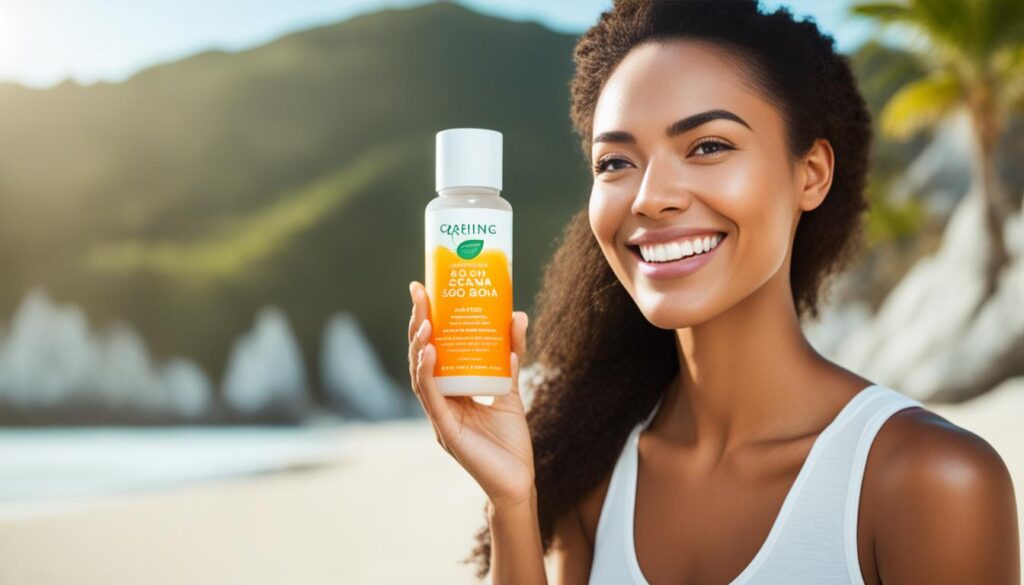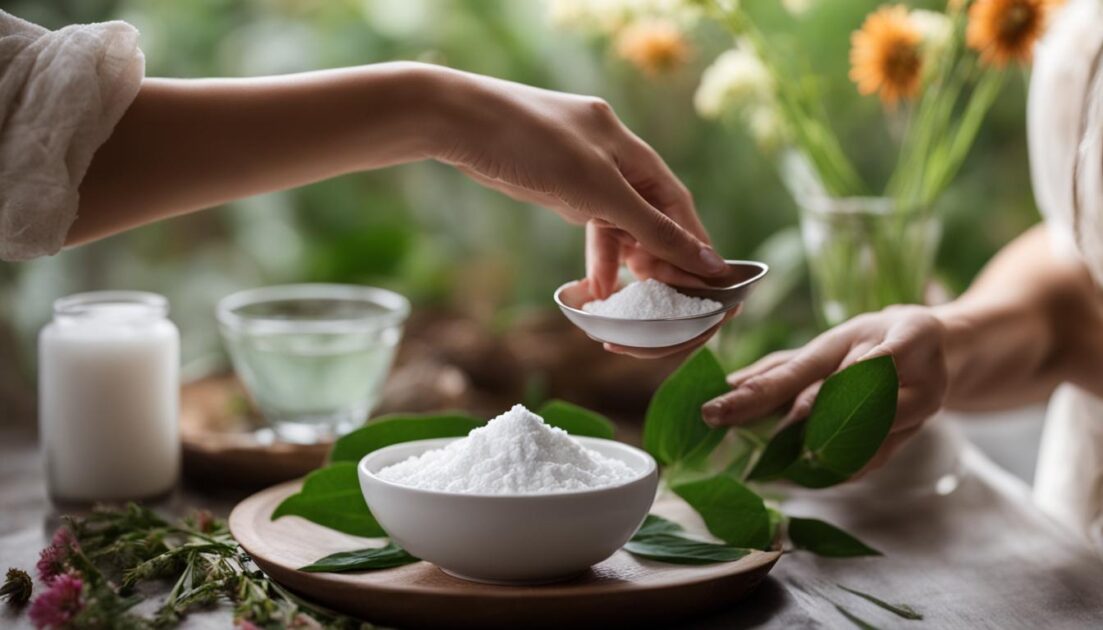Baking soda, also known as sodium bicarbonate, is a versatile and natural ingredient that can greatly improve the health and appearance of your skin. Its numerous benefits for various skin concerns make it a favorite in the world of skincare. With its exfoliating, antibacterial, anti-inflammatory, and pH balancing properties, baking soda can be your go-to solution for acne, pores, skin glow, oily skin, dead skin cells, skin infections, hair removal, body odor, foot soak, and lip care.
It is essential, however, to use baking soda in the right way and in appropriate quantities to avoid any potential side effects. Overuse or improper application can lead to dryness, irritation, and other undesirable skin reactions. As with any skincare ingredient, caution and moderation are key.
Key Takeaways:
- Baking soda, or sodium bicarbonate, is a versatile ingredient with numerous benefits for skincare.
- It is known for its exfoliating, antibacterial, anti-inflammatory, and pH balancing properties.
- Baking soda can help address various skin concerns such as acne, pores, skin glow, oily skin, dead skin cells, skin infections, hair removal, body odor, foot soak, and lip care.
- Caution should be exercised when using baking soda to avoid potential side effects such as dryness, irritation, and other skin reactions.
- Proper usage and moderation are important for optimal results and skin health.
Benefits of Baking Soda for Skin
Baking soda is a versatile and effective ingredient for improving the health and appearance of your skin. It offers a range of benefits that can address various skin concerns, making it a popular choice for natural skincare routines.
1. Clearing Acne and Breakouts: Baking soda acts as an exfoliant, helping to remove dead skin cells and unclog pores. It also has anti-inflammatory properties that can reduce redness and swelling associated with acne. Additionally, its antibacterial properties help fight the bacteria that cause breakouts.
2. Tightening Pores: Baking soda can help tighten enlarged pores, giving your skin a smoother and more refined appearance.
3. Adding a Healthy Glow: Regular use of baking soda on the skin can help achieve a radiant and healthy glow. It helps remove dull and dry skin, revealing a fresher and brighter complexion.
4. Mattifying Oily Skin: If you have oily skin, baking soda can be beneficial for controlling excess oil. It absorbs the oiliness on the skin’s surface, leaving your skin looking matte and less shiny.
5. Removing Dead Skin Cells: Baking soda’s exfoliating properties help slough off dead skin cells, promoting a smoother and more even skin texture. It can reveal a fresh layer of skin and improve the absorption of skincare products.
6. Fighting Skin Infections: Baking soda has antimicrobial properties that can help combat certain skin infections. It can help reduce itching, inflammation, and discomfort associated with conditions like athlete’s foot, insect bites, and rashes.
7. Aid in Pain-Free Hair Removal: When used as a gentle exfoliant, baking soda can help soften the hair follicles and make hair removal less painful. It can also prevent ingrown hairs and soothe irritated skin after hair removal.
8. Combatting Body Odor: Baking soda’s alkaline nature helps neutralize odor-causing bacteria on the skin. It can be used as a natural deodorant to control body odor and keep you feeling fresh throughout the day.
9. At-Home Foot Soak: Baking soda can be used as an ingredient in a foot soak to help soften and detoxify the feet. It can be mixed with warm water and essential oils to create a relaxing and rejuvenating foot spa experience.
10. Providing Lip Care: Baking soda can be used to exfoliate and soften the lips. It helps remove dead skin cells, leaving your lips smooth and supple. You can create a DIY lip scrub by mixing baking soda with honey or coconut oil.

These are just some of the benefits that baking soda can offer for your skin. Its versatile nature and multiple properties make it a valuable ingredient for various skincare concerns. However, it is important to use baking soda in moderation and as part of a well-balanced skincare routine to avoid any potential side effects.
How to Use Baking Soda for Skin
Incorporating baking soda into your skincare routine can be done in various ways to address different skin concerns. Here are some effective methods to utilize the benefits of baking soda:
- Mix 1-2 teaspoons of baking soda with a gentle facial cleanser and warm water to create a paste for acne and breakouts. Apply the paste on the affected areas, leave it on for 10-15 minutes, and rinse off with warm water.
- Combine baking soda with water to create a toner for tightening pores. Apply the mixture on your face using a cotton pad or spritz it directly onto the skin.
- For a glowing complexion and to lighten spots or blemishes, mix baking soda with lemon juice. Gently massage the mixture onto the skin and leave it on for a few minutes before rinsing off.
- To combat oily skin and remove dead skin cells, create a paste by mixing baking soda with honey. Apply the mixture on your face, massage in a circular motion, and rinse thoroughly.
- Treat skin infections by combining baking soda with coconut oil. Apply the mixture on the affected area to help soothe and heal the skin.
- For pain-free hair removal, make a paste using baking soda, turmeric, and water. Apply the paste to the desired areas, leave it on for a few minutes, and wipe it off gently.
- For foot care, enjoy an at-home foot soak by adding baking soda to warm water. Soak your feet for 15-20 minutes to help remove odor and soften calluses.
- For natural lip care, create a DIY lip scrub using baking soda. Mix baking soda with a small amount of honey or coconut oil, gently exfoliate your lips in a circular motion, and rinse off with warm water.
These methods allow you to maximize the benefits of baking soda for your skin in a safe and effective manner.
| Baking Soda Skincare Recipes | Ingredients | Instructions |
|---|---|---|
| Baking Soda Acne Paste | Baking soda, gentle facial cleanser, warm water | Mix 1-2 teaspoons of baking soda with a gentle facial cleanser and a few drops of warm water to create a paste. Apply the paste on acne-prone areas, leave it for 10-15 minutes, and rinse off with warm water. |
| Baking Soda Pore-Tightening Toner | Baking soda, water | Mix equal parts of baking soda and water. Apply the mixture on your face using a cotton pad or spritz it directly onto the skin. Leave it on for a few minutes and rinse off with water. |
| Glowing Complexion Face Mask | Baking soda, lemon juice | Mix 1 tablespoon of baking soda with enough lemon juice to form a paste. Gently massage the mixture onto your face, leave it on for 5-10 minutes, and rinse off thoroughly. |
| Baking Soda Honey Scrub | Baking soda, honey | Mix 1 tablespoon of baking soda with 1 tablespoon of honey to create a paste. Apply the paste on your face, massage in a circular motion for a few minutes, and rinse off with warm water. |

Image: Baking soda can be incorporated into skincare routines for its various benefits.
Safety Considerations and Side Effects
While baking soda can offer several benefits for the skin, it is important to use it cautiously and consider potential side effects. Overuse or improper application of baking soda can lead to side effects that may outweigh its positive impacts.
Potential Side Effects of Baking Soda for Skin
Using baking soda excessively or applying it inappropriately can result in various side effects:
- Overdrying of the skin: Baking soda’s alkaline nature can disrupt the skin’s natural moisture balance, leading to dryness and potential irritation.
- Wrinkling in the eye area and forehead: Baking soda’s abrasive properties may cause excessive exfoliation, which can lead to premature wrinkling, particularly in sensitive areas like the eyes and forehead.
- Increased acne breakouts and blemishes: While baking soda can help clear acne in some cases, it may worsen breakouts for others due to its pH-altering effects on the skin.
- Irritated and inflamed skin: Baking soda can irritate the skin, especially in individuals with sensitive skin or pre-existing skin conditions. It may cause redness, itching, and inflammation.
- Worsened skin rashes: If you have existing skin rashes or conditions like eczema, baking soda could potentially exacerbate these conditions, leading to further irritation and discomfort.
Allergic Reactions to Baking Soda
While allergic reactions to baking soda are rare, they can occur in some individuals. Symptoms of an allergic reaction may include:
- Redness and irritation: The skin may become red, inflamed, and itchy after applying baking soda.
- Burning and stinging: Some people may experience a burning or stinging sensation upon contact with baking soda.
- Swelling: Allergic reactions can cause swelling, particularly in the area where baking soda was applied.
If you experience any of these symptoms after using baking soda, it is advisable to discontinue use and consult a dermatologist or healthcare professional for further guidance.
Usage Recommendations and Precautions
To avoid potential side effects, follow these recommendations when using baking soda for skin:
- Perform a patch test before applying baking soda to a larger area of your skin. Apply a small amount of the mixture to a small section of skin and assess if there is any adverse reaction within 24 hours.
- Limit the use of baking soda to once or twice a week to prevent excessive drying and irritation.
- Use baking soda in appropriate quantities as directed in DIY recipes or consult a skincare professional for guidance.
- If you have sensitive skin or pre-existing skin conditions, it is advisable to consult a dermatologist before using baking soda on your skin.
By using baking soda responsibly and being aware of the potential side effects, you can safely incorporate it into your skincare routine to enjoy its benefits.
Baking Soda and the pH of Skin
When it comes to the usage of baking soda on the skin, one important consideration is its impact on the skin’s pH level. Baking soda has an alkaline nature, with a pH level of about 9, which contrasts with the skin’s natural acidic pH level. The skin’s pH typically falls between 4 and 6, creating an environment that helps retain moisture and protect against bacteria.
The alkaline nature of baking soda can disrupt the acidic pH level of the skin when applied topically. This disruption can lead to several adverse effects, including dryness, irritation, and inflammation. Using baking soda regularly or in excessive amounts can further exacerbate these issues.
However, it is worth noting that individuals with oily skin and imbalanced pH levels may benefit from the alkaline nature of baking soda. Since oily skin tends to have a higher pH level, using baking soda can help rebalance the skin’s pH, bringing it back to a healthier level. By restoring the acidic pH balance, baking soda can help regulate oil production and reduce the greasiness associated with oily skin.
Despite the potential benefits for oilier skin types, maintaining the skin’s acidic pH level is crucial for overall skin health. Using ingredients, including baking soda, that significantly raise the pH level can disrupt the skin’s natural balance and lead to various skin issues. It is important to exercise caution and avoid excessive use of baking soda or any other ingredient that alters the skin’s pH. Striking a balance is key.
Table: pH Levels of Common Substances
| Substance | pH Level |
|---|---|
| Lemon Juice | 2 |
| Baking Soda | 9 |
| Water | 7 |
| Vinegar | 3 |
As seen in the table above, baking soda’s pH level is significantly higher than that of the skin. This disparity highlights the potential impact it can have on the skin’s pH balance when used in skincare routines.

An image depicting the concept of pH balance and the impact of baking soda on the skin’s pH level.
Alternatives to Baking Soda for Skincare
While baking soda can be a tempting DIY ingredient for skincare, there are alternative ingredients that are specifically formulated to address various skin concerns. If you’re looking for effective solutions for acne, there are ingredients like salicylic acid and benzoyl peroxide that have proven benefits. Rather than relying solely on DIY remedies with baking soda, you can opt for skincare products that contain these alternative ingredients, provided they have appropriate pH levels for the skin.
Salicylic acid is a beta-hydroxy acid that helps exfoliate the skin and unclog pores. It has anti-inflammatory properties and can effectively treat acne, blackheads, and whiteheads. Look for cleansers, toners, and spot treatments that contain salicylic acid for targeted acne treatment.
Benzoyl peroxide is another ingredient commonly used to treat acne. It works by killing the bacteria that contribute to acne breakouts and also helps to remove excess oil from the skin’s surface. Skincare products with benzoyl peroxide, such as face washes, creams, and gels, can effectively reduce acne and promote clearer skin.
When choosing skincare products, it’s important to consider the pH levels. The skin’s natural pH range is between 4 and 6, which helps maintain its protective barrier and overall health. Skincare products with appropriate pH levels can ensure that the skin remains balanced and healthy. Look for products that are specifically formulated for your skin concern and contain ingredients like salicylic acid or benzoyl peroxide.
Comparing Baking Soda with Alternative Ingredients for Skincare
| Ingredient | Benefits | Effective for | Recommended Skincare Products | ||
|---|---|---|---|---|---|
| Baking Soda | – Exfoliating | – Dead skin cells | – Acne | – Oily skin | – DIY Use |
| Salicylic Acid | – Exfoliating | – Unclogging pores | – Treating acne | – Blackheads and whiteheads | – Acne cleansers, toners, and spot treatments |
| Benzoyl Peroxide | – Antibacterial | – Treating acne | – Reducing excess oil | – Acne face washes, creams, and gels |
By choosing skincare products with appropriate pH levels and ingredients specifically designed to address your skin concerns, you can enhance the effectiveness of your skincare routine and maintain a healthy and balanced complexion.
The Importance of Proper Skincare and pH Balance
Maintaining a healthy pH balance is crucial for overall skin health. The skin has a natural acidic pH level that helps retain moisture and protect against bacteria. Disrupting this pH balance, particularly with high alkaline products like baking soda, can lead to dryness, irritation, and acne.
It is essential to choose skincare products with appropriate pH levels and to avoid overusing or misusing ingredients that can raise the pH level of the skin. By maintaining a healthy pH balance and following a proper skincare routine, you can promote clearer and healthier-looking skin naturally.
High alkaline products can have potential harm on the skin. When the skin’s pH balance is disrupted, it can strip away the natural oils, cause inflammation, and create an environment for acne-causing bacteria to thrive. Using high alkaline products like baking soda without proper care and moderation can damage the skin’s protective barrier, leading to various skin issues.
To maintain a healthy pH balance, it is important to incorporate skincare products that are formulated to respect the skin’s natural acidity. Look for cleansers, toners, serums, and moisturizers that have a pH level close to the skin’s natural pH range of 4 to 6. This will help preserve the skin’s moisture, support its natural defenses, and promote a healthy and radiant complexion.
FAQ
What are the benefits of using baking soda on the skin?
Baking soda offers several benefits for the skin, including exfoliating, improving acne and breakouts, tightening pores, adding a healthy glow, mattifying oily skin, removing dead skin cells, fighting infections, aiding in hair removal, combating body odor, and providing lip care.
How can I use baking soda for my skin?
Baking soda can be used in various ways for the skin. It can be mixed with water and a facial cleanser for acne and breakouts, used as a toner to tighten pores, combined with lemon juice for glow and lightening spots, mixed with honey for oily skin and exfoliation, combined with coconut oil for infections, and mixed with turmeric and water for pain-free hair removal. It can also be used as a foot soak and lip scrub.
What are the safety considerations and possible side effects of using baking soda on the skin?
Baking soda should be used cautiously, as overuse or improper application can lead to dryness, wrinkling, increased acne breakouts, skin irritation, inflammation, and allergic reactions. It is recommended to do a patch test and use baking soda no more than once or twice a week to avoid these side effects.
How does baking soda affect the pH of the skin?
Baking soda has an alkaline nature with a pH level of about 9, which can disrupt the natural acidic pH level of the skin. This can lead to dryness, irritation, and inflammation. However, for individuals with oily skin and imbalanced pH levels, baking soda can help balance the skin and bring it back to a healthier pH level.
Are there alternatives to baking soda for skincare?
Yes, there are alternative ingredients specifically formulated for skincare concerns. Ingredients like salicylic acid and benzoyl peroxide are effective for treating acne and can be found in various skincare products with appropriate pH levels.
Why is proper skincare and maintaining a healthy pH balance important?
Maintaining a healthy pH balance is crucial for overall skin health. Disrupting the skin’s natural acidic pH level can lead to dryness, irritation, and acne. It is important to choose skincare products with appropriate pH levels and avoid ingredients that significantly raise the pH level of the skin.






